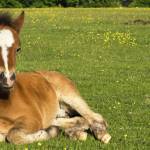Sliding While Standing May Contribute to Osteochondrosis in Foals

Watching a young foal struggling to stand seems comical, eliciting chuckles and Facebook “likes,” but new research suggests limb-sliding while attempting to stand may contribute to the development of osteochondrosis (OC), an orthopedic disease of young horses characterized by abnormal cartilage formation.
“Factors traditionally thought to contribute to OC include genetics, rapid growth, trauma, and dietary imbalances,” explained Laura Petroski, B.V.M.S., a veterinarian at Kentucky Equine Research (KER).
Recent research indicates that excessive pressure can be exerted on certain joints, such as the fetlock, hocks, and stifles, when a limb slips sideways while trying to stand. In turn, these abnormal forces can damage the blood supply to the articular cartilage that lines the ends of the bones inside the joints, resulting in necrosis of the cartilage.
To test the theory that acute joint overload due to out-of-plane movements contributed to OC in foals, 50 group-housed Dutch Warmblood weanlings (6 to 12 months old) residing on five different farms were observed. Surveillance cameras were used to note standing behavior, and OC scores were obtained radiographically.
The researchers found the following:
- Foals experienced limb-sliding during 29% of all attempts to stand.
- At the start of the study, when foals were 6 months old, approximately 75% were diagnosed with OC affecting one or more joints. By 12 months of age, 62% of foals were diagnosed with OC.
- Approximately one-quarter of all foals with OC at 6 months old recovered, while an additional 10% of foals developed OC between 6 and 12 months of age.
- Fifty-two percent of foals with OC at 6 months old still had lesions at 12 months of age.
- The rate of sliding differed between farms, likely due to the different housing situations (e.g., type of flooring, condition of turnout areas), and foals experienced less sliding when they had time to prepare for standing as opposed to being startled or rising quickly.
“This study found a causal relationship between environmental factors and sliding when standing with incidence of OC. Considering how important and common this condition remains in foals, more research in this field is needed,” summarized Petroski.
Feeding a balanced diet contributes to the development of a healthy musculoskeletal system. Consider offering a high-quality joint supplement to healthy, growing foals. Research shows that prophylactic administration of supplements helps protect joints from damage caused by trauma.
“KER offers several joint supplements, including KER•Flex, with chondroitin sulfate and glucosamine hydrochloride; Synovate HA with high-molecular weight hyaluronic acid; and EO•3, a marine-derived source of both DHA and EPA,” described Petroski.
Australian horse owners should also look for Glucos-A-Flex.
Do you need help assessing your weanling’s diet? Consult with an KER equine nutrition advisor today.
*van Grevenhof, E.M., A.R.D. Gezelle Meerburg, M.C. van Dierendonck, et al. 2017. Quantitative and qualitative aspects of standing-up behavior and the prevalence of osteochondrosis in Warmblood foals on different farms: Could there be a link? BMC Veterinary Research. 13(1):324.








